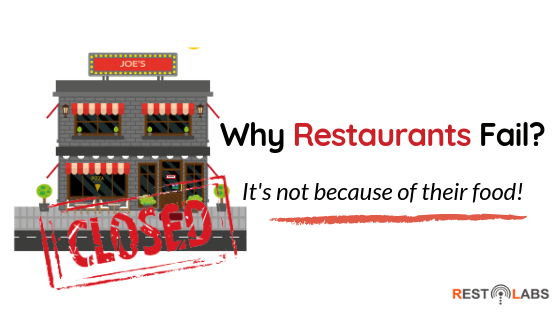Key Takeaways
Businesses are challenging. They demand dedication, planning, strategy and most of all, capital. The restaurant business is no exception. If you opened a restaurant thinking that you can start making money right away, then you really don't know what you are getting into.
“If you don't know your numbers, you are not going to realize the maximum potential of the business. If you don't know how to make drinks or step into the kitchen when needed, you may have to face a setback.”
Building a restaurant is as much about what you do, as what you don't do. The successful managers are the ones who understand all the aspects and know how to do them right.
If you’re a first-time restaurateur, you can expect to make a number of mistakes even before you begin operations. With so many difficult decisions and complex challenges to ruminate over, the key to success is to avoid making mistakes that have been responsible for most restaurants failing.
Here are the 5 most common mistakes to look out for as you go through the process of opening a new restaurant.
Not having a business plan
A renowned Chef in Seattle has 20 years of experience in the restaurant industry. Over the years he had gained immense knowledge of kitchen operations, staff management, menu designing, and inventory management. One day he decides to open a restaurant, but due to lack of capital and planning, he had to shut it down in less than 10 months.
Simply put, not everyone is cut out to run a business. If everyone would be an entrepreneur, who would be the employee. Some people think that being their own boss would make life easier for them, but only a few make an honest realistic evaluation.
How to fix this mistake: A business plan for any new venture is essential for success. It helps the owner set up realistic expectations and goals that eventually save the business owner from making costly mistakes in the long run. While a business plan takes time to create, it will be time well spent if it helps you set future objectives and strategies to achieve them.
Not investing in the right technology
Successful restaurateurs work for their business, not on their business. But until proper systems are implemented, that can’t happen. If you don’t invest in proper operational systems that your staff can follow and customers can engage with, you're preparing your business for a complete failure.
How to fix this mistake: Technology is the solution! Consumer demand convenience and speed, and the key to success is to respond by adopting and implementing more sophisticated layers of technology into day-to-day operations. Restaurant owners are pouring millions into enhancing customer experience through innovative technologies such as chatbots, mobile and online ordering, digital inventory tracking, kiosk ordering, mobile payments and so on. Read how technology has been a game-changer for the restaurant industry.
Not paying attention to menu design & engineering
The menu is your sales brochure. A well-designed menu has the potential to reinforce your brand personality. Perhaps to do so effectively, one needs to have an in-depth understanding of customers' predilections. Having too many choices and complicated names can overwhelm customers, leaving a poor first impression on them. Another common mistake first-time restaurant owners make is to focus on what they can serve/cook easily and forget the technical aspect of menu engineering. As a result, customers default to the most common and least profitable items. Read about the menu design hacks that can help first-time restaurateurs nail this important piece of marketing collateral.
How to fix this mistake: The menu should be a good mix of high cost and low-cost items. Menu engineering a vital process of achieving potential profitability. So consider each item from the perspective of its profit margin and popularity. The most popular and profitable items should be placed at the top of a menu.
Not giving importance to marketing
The restaurant industry is a complex field that can frustrate even the most seasoned entrepreneur. Just because you've opened a new restaurant that serves great food and exotic ambiance, people aren’t going to flock to you. There’s nothing worse than a silent restaurant opening. When you don't invest in marketing and PR, you set up your business to get off to a very rocky start.
How to fix this mistake: Instead of just opening and hoping that customers will line up to get in, promote yourself. Once you decide the launch date, invite journalists, food critic, and bloggers who can help you to attract the right audience to your restaurant. Send a press release talking up your new restaurant, and make it an event too strong to hit the journalists' mind. For more marketing ideas for restaurants, click here.
Not knowing your costs
If you don't know your numbers, the chances are that you'd end up spending the entire capital in setting up the restaurant, and not saving enough working capital for later. It is better to start small and keep a healthy working capital that would support operations for at least a year. The delusion is that the restaurant will start making a profit from the first month. Truth is, it takes some time to reach the breakeven point.
How to fix this mistake: You must create a business plan before looking at locations or hiring employees. Create a budget based on what you can spend, estimate how much money you need for promotions, and project your future profit margins. If you're low on capital, start small with a delivery only kitchen. Cloud kitchen or delivery-only kitchen is a place where food is prepared and delivered by taking orders via calls and online ordering. It lessens the burden and lets the restaurateurs focus on the quality of food with minimum effort, time and money. Read why cloud kitchen is a recipe for success and how you can start your own business with low investment.
These are the five most common mistakes first-timers make, but there are plenty more why they are forced to shut down their dream project. Keep in mind that although it is tedious, a lot of planning and research goes into developing a successful business model. Avoiding these mistakes will help you be one step closer to being a roaring success
How can we help?
We help restaurants get started with our all-in-one online ordering software for restaurants. We’ve studied what’s worked and what hasn’t worked for all kinds of establishments. With this intel, many first-time restaurateurs have been able to avoid operational blunders as well as reduce the amount of capital investment required to launch.
If you have doubts or simply wish to share your personal experiences, please don’t hesitate to use the comment box below.
Frequently Asked Questions


.gif)



.png)




